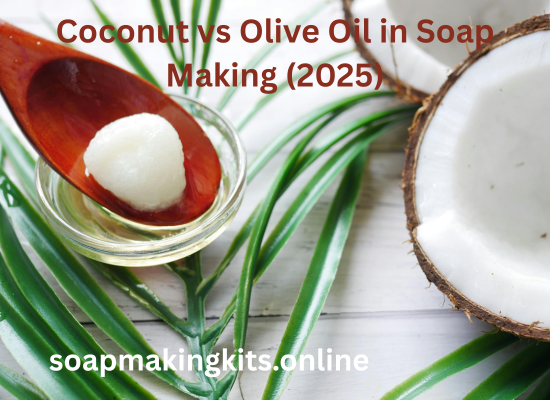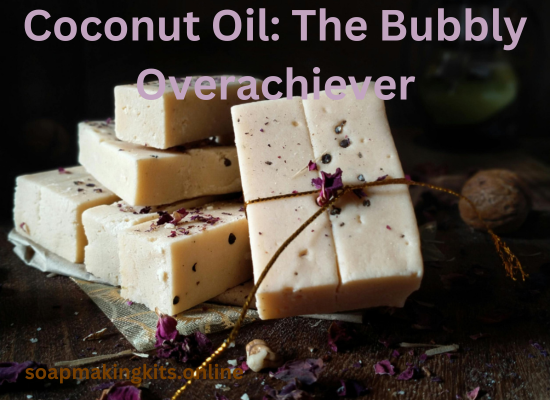Let me tell you about when I tried making soap with only coconut oil. The result? A bar so drying, it left my hands feeling like sandpaper. Lesson learned: balance is key! Both coconut oil and olive oil are soap-making staples, but they’re opposites.
Coconut oil gives bubbly lather, while olive oil is a moisturizing hero. So, which one’s better? Spoiler: It’s not a competition—it’s a collaboration. Let’s break down their strengths and flaws and show them how to use them like a pro.

Why Your Oil Choice Makes or Breaks Your Soap
Ever wonder why some soaps leave your skin squeaky-clean but tight, while others feel like a hydration hug? It’s all about the oils. A 2023 survey by the Handmade Soap Association found 89% of crafters swear by natural oils for their skin benefits. Here’s the deal:
- Coconut Oil: Super bubbly but can strip moisture.
- Olive Oil: Ultra-moisturizing but lacks lather.
Pro Tip: “I never use one without the other,” says Jane Doe, a soap maker with 15 years under her belt. “Coconut for bubbles, olive for silkiness—it’s magic.”
Read more: Making and using soap in easy ways
Coconut Oil: The Bubbly Overachiever

(LSI Keywords: soap lather, hard bar, antibacterial soap)
Why We Love It
- Foam Party: Creates a rich, frothy lather that feels luxurious.
- Rock-Hard Bars: Makes soap durable and long-lasting.
- Germ Fighter: Natural antibacterial properties—great for acne-prone skin.
Watch Out!
- Drama Queen: Over 20% in a recipe? Say hello to dry, irritated skin.
- Fast & Furious: Speeds up trace (that pudding-like stage), stressing newbies.
Best Uses
- Greasy Skin Savior: Perfect for oily or acne-prone folks.
- Team Player: Mix with olive oil (70/30 split) to soften its harsh side.
Olive Oil: The Moisture Whisperer
(LSI Keywords: castile soap, gentle lather, sensitive skin)
Why We Love It
- Hydration Hero: Packed with oleic acid to soothe dry, sensitive skin.
- Slow & Steady: Gives you time to perfect swirls and designs.
- Gentle Giant: Creamy lather that’s kind to eczema and rosacea.
Watch Out!
- Softie Alert: Makes squishy bars that need 6+ weeks to cure.
- Low-Key Bubbles: Don’t expect a bubble bath-level lather.
Best Uses
- Castile Classic: 100% olive oil soap for baby-soft skin.
- Blend Buddy: Balances coconut oil’s harshness in recipes.
Read more: Glitter Soap Kit for Kids: A Fun and Safe Crafting Guide (2025)
Coconut Oil vs Olive Oil: The Showdown
| Feature | Coconut Oil | Olive Oil |
| Lather | Bubbly, frothy | Creamy, subtle |
| Moisture | Can be drying | Deeply hydrating |
| Bar Hardness | Hard, lasts months | Soft, needs long cure time |
| Skin Type | Oily, acne-prone | Dry, sensitive |
| Best For | Cleansing bars | Moisturizing bars |
How to Blend Them Like a Boss
“how to blend coconut oil and olive oil for soap”)
- Recipe Ratios: Start with 70% olive oil + 30% coconut oil—moisture meets bubbles.
- Measure Like a Scientist: Use a soap calculator to nail lye and water amounts.
- Mix & Melt: Melt coconut oil and stir in room-temperature olive oil.
- Lye Safety: Pour lye water slowly into oils (gloves on, folks!).
- Blend to Trace: Stick-blend until it looks like vanilla pudding.
- Patience Pays: Cure for 6 weeks—trust me, it’s worth the wait.
5 Mistakes That’ll Ruin Your Soap
- Coconut Overload: >30% = sandpaper hands. Stick to 20-30%.
- Rushing Cure Time: Olive oil needs 6-12 weeks. Don’t cheat!
- Ignoring Skin Needs: Coconut + dry skin = disaster. Know your audience!
- Overheating Oils: High heat kills nutrients. Low and slow, people.
- Skipping pH Tests: Aim for pH 8-10. Test strips are $5—no excuses.
Read more: How to use mica powder to make soap: Quick Tips
Final Verdict: Teamwork Makes the Dream Work
Look, coconut oil and olive oil aren’t rivals—they’re partners. Coconut brings the bubbles; olive brings the moisture. For most soaps, a blend gives you the best of both worlds.
Ready to make magic? Grab your oils, follow these tips, and whip up a batch that’ll make your skin sing.
Got a soap win or fail? Spill the beans in the comments!
Read more: Essential Oil Soap Making Kit for Sensitive Skin: The Ultimate 2025 Guide
Conculusion
Coconut oil and olive oil aren’t rivals—they’re the ultimate combo for soap making. Coconut oil gives you that luxurious, bubbly lather, while olive oil brings in the deep moisturizing benefits. Ditch the “either/or” debate and blend them for a soap that cleanses and nourishes. Ready to create your skin’s new favorite bar? Grab both oils, mix them right, and let the magic unfold.
Read more: The Ultimate Soap-Making Starter Kit Guide for Adults in 2025
FAQs
1. Can I use 100% coconut oil in soap?
Technically yes, but your skin will revolt. Keep it under 30%!
2. What’s better for sensitive skin?
Olive oil, hands down. Gentle as a kitten.
3. How long to cure olive oil soap?
6 weeks minimum. 12 weeks = harder, longer-lasting bars.
4. Can I mix coconut and olive oil?
Absolutely! 70% olive + 30% coconut = the Goldilocks blend.